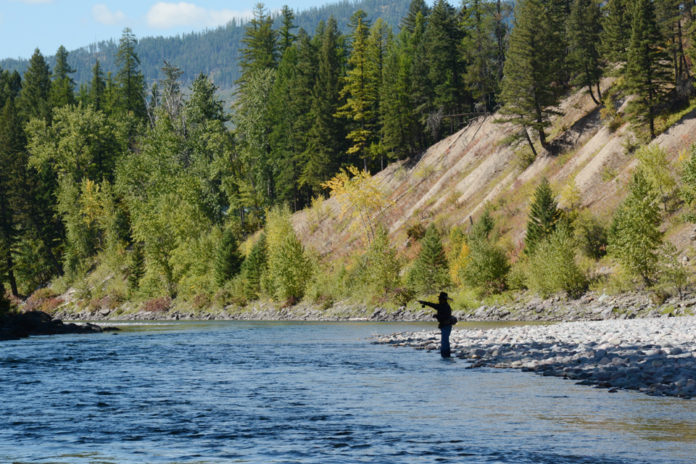
For the second year, a conservation coalition is asking Montana’s governor to create a task force to protect the struggling streams and fisheries of southwestern Montana. With the current drought outlook, the need is just as great as it was last year.
On Wednesday, a broad coalition of fly-fishing businesses, conservation organizations, and 875 concerned citizens submitted a second petition to Gov. Greg Gianforte, asking him to create a multi-agency Cold Water Fisheries Task Force to develop strategies to preserve fish populations that are dwindling in the Upper Missouri tributaries that are parched by drought.
That includes not only the dwindling Madison and Jefferson rivers but also the Big Hole River south of Anaconda and the Beaverhead and Ruby rivers. All have suffered from low streamflows due to successive winters with low snowpack and high irrigation demands due to sustained summer heat and drought.
“We urge the formation of a cross-government, multi-agency task force that would begin an important process of identifying meaningful policy changes, seeking proactive agreements with landowners, and implementing science-based long-term solutions to address the declining health of Montana’s iconic cold water fisheries,” the petition said.
Led by Upper Missouri River Waterkeeper, the coalition includes Montana Backcountry Hunters and Anglers, the Clark Fork Coalition, the Fishing Outfitters Association of Montana and Montana Wildlife Federation and businesses such as Orvis and Patagonia, to name a few.
Starting in June last summer, several “heat domes” moved in and sat on top of Montana for days, lifting daytime temperatures into the triple digits while nights barely dipped below 80 degrees. Streams dropped quickly and their waters warmed to temperatures that threatened native trout that require cooler waters to survive. Conditions worsened to the point they could affect even nonnative rainbow trout, which can take slightly higher temperatures.
To minimize trout mortality, Montana Fish, Wildlife & Parks had to implement hoot-owl closures early in the season. Hoot-owl closures stop fishing during the hot part of the day if streamflows get too low or water temperatures peak above 73 degrees for more than three days. In the past, hoot-owl closures normally haven’t been needed until late August. But last summer, the Ruby River was the first to close in mid-June and closures on other southwestern rivers soon followed.
Even with the hoot-owl closures, trout suffered. Brown trout populations started decreasing throughout southwest Montana about eight years ago, and last year’s low flows didn’t help. While the low warm rivers hurt all brown trout, it’s particularly hard on juveniles.
Worried about the effects of the summer, a stakeholders’ group developed a plan that would have closed sections of several southwestern rivers to try to protect spawning areas and help brown trout populations recover from a six-year crash. The plan got little traction with the FWP commission.
In October, the coalition sent its first letter to Gianforte asking for a cold-water fisheries task force. The governor never responded.
This summer, even though April and May have been cool and snowpack reports look good, Arin Peters told the Legislative Environmental Quality Council on Wednesday that the water situation could still get ugly fast. The National Oceanic and Atmospheric Administration hydrologist said the southern part of the state has received more precipitation than the north-central part this year, but the entire state still has low soil moisture.
“We’re severely lacking in soil moisture. Even though we’ve seen some improvement in precipitation (this spring), that soil moisture hasn’t recovered, because anything that falls is getting taken up into the plants right away. The long-term effects of that are starting to play out in our streams and other resources,” Peters said.
Peters said many streams across the state are flowing at about a 10th of where they should be right now. Although part of that is due to cool weather delaying mountain runoff, the main culprit is last year’s drought, which was the worst it’s been since drought monitoring started 22 years ago, Peters said. By December, a third of the state was suffering exceptional drought.
“Streams lag the agricultural and meteorological impacts of drought. We’re really seeing now what is the result of that dry summer we had last year and the heat as well. We’re really hurting for streamflow across the state,” Peters said.
To avoid a repeat of last summer’s drought, an exceptional precipitation event is required and it’s not going to happen. The three-month outlook shows a good chance for above normal temperatures and below normal precipitation through the summer. Meanwhile, snowpack percentages only look good because they’re normally beginning to melt out by now. But the total winter accumulation wasn’t that good in several ranges, particularly in the southwest.
“We never really peaked out. We were well below that on April 15,” Peters said. “The overall water supply for most basins is lower than it should be.”
Knowing rivers can drop fast once the summer heats up, the coalition is asking again for the task force.
“Montana BHA hopes that Gov. Gianforte will respond proactively to our worsening water situation in order to save our world-class trout fisheries that bring in hundreds of millions of dollars of revenue all over the state,” said Graham Coppes, Montana Backcountry Hunters and Anglers Conservation Leader. “It is high time for Montana to take control of its water future and take strong action to ensure that our cold-water fisheries continue to be the envy of the world. Creating a task force to address the well-documented and ongoing demise of our trout fisheries is an obvious first step.”
Contact reporter Laura Lundquist at lundquist@missoulacurrent.com.
Credit: Source link































